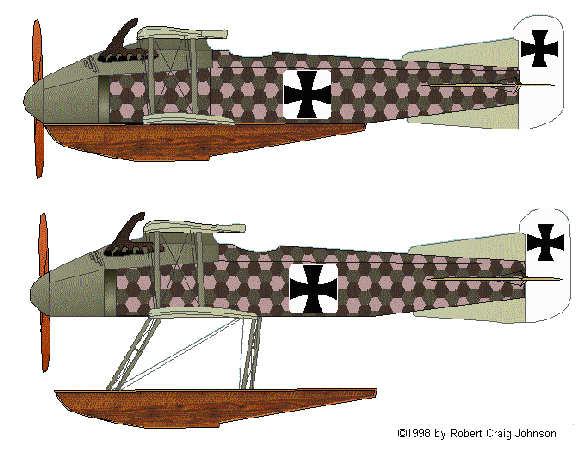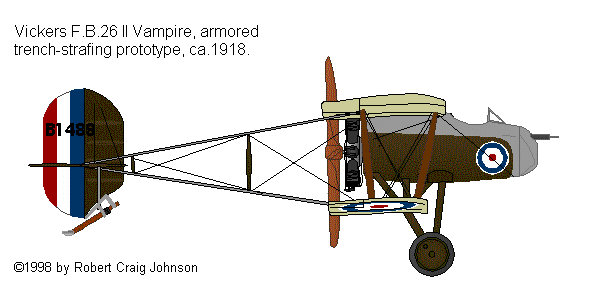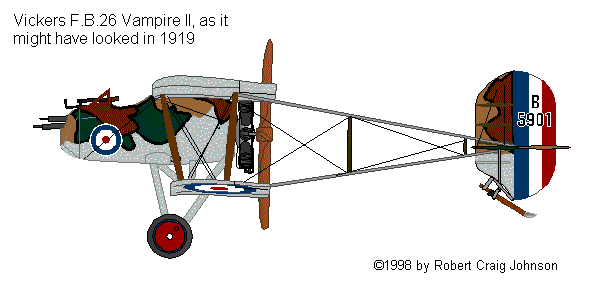
The First World War gave innovators and entrepreneurs tremendous scope for realizing their ambitions. The pace of wartime technical development was such that many visionary projects received funding from hidebound military and naval establishments that would never have considered such things in peacetime. Heavy industrial concerns, particularly those that had sold weapons pre-war, had endless opportunities for developing and cornering new markets and emerging military technologies.
Oskar Ursinus definitely belonged to the former category. Professor Ursinus was the founder (in 1908) and editor (till 1945) of the German flying magazine, Flugsport and a well-known gliding enthusiast. When he entered the army in 1914, he offered his services as an aircraft designer. From the first, Ursinus' designs were well outside the limits established by contemporary industry practice. He began with a series of unusual sea and land biplanes, all of which featured a slender fuselage attached to the upper wing and twin engines set very close together on the lower wing, so that the propellor tips almost touched. This arrangement was meant to provide superior fields of fire for gunners and to overcome the effects of asymetrical thrust and torque in the event of an engine failure. The first machine, a Kampfflugzeug ("battle plane"), was a three-man ground-attack aircraft with a planned six-hour endurance, two 100-hp engines, 2 machine guns, and 200 kg of chrome-nickel armor surrounding the flight crew and powerplants. While it generally achieved Ursinus' aims—visibility and engine-out control were reportedly excellent for the period—the aircraft proved fragile, underpowered, and generally hard to handle. The armor was removed, and it served briefly as a bomber until as late as 1917, when it was still in service as a testbed for the new, Becker 20-mm cannon. In 1915, the Gotha works took over Ursinus' patent and produced a re-engineered version as the Gotha G.1, the first of the famous twin-engined bombers from this firm.

In the meantime, Ursinus was not idle. Despite his army enlistment, he remained interested in seaplanes. His first attempt, the Gotha-Ursinus UWD of 1915 was essentially a revised version of the ground-attack plane mounted on floats. But the second type, the fighter seaplane prototype of 1916, was like nothing extant. To reduce drag, Ursinus designed a retractable twin-float undercarriage. When the pilot turned a crank (a no-doubt exhausting operation), the floats swung up and back to lie flush with the bottom of the fuselage. To maintain the correct center of gravity both on the water and in the air, Ursinus had to mount the 150-hp Benz Bz. III engine and its twin, side radiators well back in the fuselage, under the wing, whence it drove the propeller through an extension shaft. The aircraft spanned 29 ft 6 in, and it was 25 ft 6.5 in long and 9 ft 6 in high with the floats extended. It weighed 1649 lbs empty and 2205 lbs loaded.
Ursinus calculated a remarkable top speed of 200 km/hr (124 mph), comparable to the Sopwith Snipe of 1918 and faster than the vaunted Fokker D.VII. Unfortunately, the sole prototype was destroyed during sea trials, before this remarkable prediction could be tested.
If Oskar Ursinus' fighter seaplane epitomizes the amateur enthusiasm and inventive genius that drove so much of the aeronautical innovation in the Great War, our second subject, the Vickers F.B.26A Vampire II, is no less representative of the other great force behind the advances of 1914-1918: the great, war-profiteering industrial combine. Under its sinister chairman and managing director, Basil Zaharof (the original "merchant of death"), Vickers-Armstrong had, by the end of the 19th century, emerged as one of the largest, most aggressive, most highly diversified arms manufacturing enterprises in history. Vickers could supply everything from machine guns and small arms ammunition to battleships (complete with their guns, armor, engines, and fire control equipment) from its own resources. When the military potential of the airplane became apparent, aircraft manufacture became a natural extension of the company's business. In 1913, Vickers introduced one of the first purpose-built armed aircraft, a two-seat, machine gun-armed pusher biplane called the Destroyer. A development of the aircraft, the FB5 "Gunbus," served in some numbers during the war.
Unfortunately, after the FB5, Vickers did not have much luck selling airplanes to the armed forces. Though sometimes excellent performers, Vickers aircraft always seemed to arrive on the scene just after some other type had been standardized for large-scale production. Basil Zaharof's celebrated readiness to advance his firm's interests at all costs and by all means, fair or foul, did little to help matters. Having once invested company money in a design, only to see it rejected, Vickers tended to persist, making minor modifications and counting on its formidable lobbying power to reverse the adverse decision. As a result, the company's offerings tended to fall behind the standards of the times. Notably, the company persisted with pusher-type fighters long after the fashion for them had waned.
In 1916, Vickers produced a pusher fighter biplane, the FB 12, as a replacement for the then-standard DH2 and FE8 fighters. Vickers designed the fighter around a new and untried engine fof unprecedented power, the 150-hp Hart air-cooled radial. The difficulties of cooling a high-powered, static engine with air had not yet been mastered, however, and the Hart never materialized. The FB12 had to make do with 80-100 hp Le Rhône and Gnome rotaries or with the highly unreliable 100-hp, 10-cylinder Anzani radial. Performance was good, given the power—95 mph. But this was really no better than the DH2s and FE8s it was meant to replace, and, with a single Lewis gun, it was no better armed. Tractor types were now, moreover, the fashion for fighters. The FB12 had simply arrived too late with too little.
Vickers was not prepared to take no for an answer, however. In May 1917, the firm rolled out a developed version of the FB12 design, the FB26 Vampire. A 200-hp Hispano-Suiza water-cooled V8 replaced the air-cooled engines, and the fuselage was now attached directly to the top wing, rather than suspended between the wings as in the case of the FB12. Armament consisted of a pair of Lewis guns mounted in the nose or three of the weapons mounted on an experimental, trainable Eeman mount. Flare brackets and night-flying equipment were included, so that the Vampire could serve as a night fighter. It was not a success, however. Service pilots (including J.T.B. McCudden, then an instructor at Joyce Green), found it fast, but a poor climber. Spinning characteristics were considered dangerous.

Stymied once more, Vickers set about the third and last reincarnation of its unsuccessful 1916 fighter. In 1918, the FB26A Vampire II emerged as an armored trench fighter powered by a 230-hp Bentley BR2 rotary engine, the engine used in the Sopwith Snipe and a rival trench fighter, the Sopwith Salamander. The pusher configuration at last had some advantages, given the change of role. Visibility was excellent, particularly forward and downward and up and to the the rear, the crucial directions for a ground-attack pilot. More importantly, the layout placed the mass of the armor (more than 500 lb) where it could protect both the pilot and the engine. With the new engine, the airplane proved remarkably maneuverable and fast, reaching 121 mph at sea level. While this was fully comparable to its rival, the Salamander, the latter was by now already in production. Moreover, Salamander and Snipe production placed heavy demands on the limited number of Bentley radials available. With this in mind, Vickers redesigned the Vampire II for the 320-hp ABC Dragonfly air-cooled radial, then entering very large-scale production. The complete failure of the Dragonfly, the success of the Salamander, and the imminent end of the war combined to, at last, lay the long line of Vickers pusher fighters to rest.

© 1998 by Robert Craig Johnson.